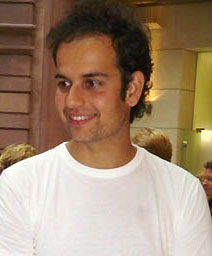Sehgal's Medium is the Human Mind and Energy
by Carol Strickland, 2/16/2010
 This
year, the Guggenheim Museum showcased "Tino Sehgal," a "performative
installation" that required visitor participation. As the 34-year-old
artist said, "When you enter my work, you are also constructing it."
This
year, the Guggenheim Museum showcased "Tino Sehgal," a "performative
installation" that required visitor participation. As the 34-year-old
artist said, "When you enter my work, you are also constructing it."
Sehgal, who was born in London but lives and works in Berlin, aims to
elicit two-way conversations through what are called "constructed
situations."
Why the artist eschews conventional art objects: A student of economics
and former dancer and choreographer, Sehgal maintains that the developed
world has too much stuff. His favored means of creating art does not diminish
Earth's dwindling resources or contribute to the excess of consumer goods.
His art exists only transiently and leaves no physical trace. Sehgal's
art lives during the experience and afterward persists in memory and legend.
He permits no photographic, video, or audio record and no catalog or wall
labels.
Instead of transforming material like canvas or a chunk of marble into
an art object, Sehgal's medium is the human body, mind, and energy. His
goal is to transform participants' thoughts and values. It's the Socratic
method made visible, as much linguistic and dramatic as it is visual art.
The Guggenheim show had two parts: one was a visual tableau and the other
required direct participation. The former, "Kiss," showed a
young man and woman sprawled on the floor of the rotunda, enacting in
slow motion scenes from works of art that involve a kissing couple.
The participatory part, called "This Progress," wound up the
ramps of the Guggenheim's spiral. "It's the perfect place" for
this work, Sehgal said. "Every museum promotes the Western idea of
progress, and this one epitomizes it" in its spiral form ascending
to an oculus of pure light. It also suggests that progress, Sehgal says,
is "nonlinear."
He hopes to catalyze fresh thinking about the concept. "In the last
200 or 300 years, the Western idea of progress," he says, "is
to transform the earth through human labor into material things, which
we consume and derive income from and which make us happy." He denies
that "having the next gadget" increases happiness and proposes
an alternative of "higher level" satisfaction found in interpersonal
relationships.
"This Progress" consisted of serial conversations between each
visitor and four interpreters ranging in age from schoolchildren to senior
citizens. On entering the bottom ramp, a child says, "This is a work
by Tino Sehgal. May I ask you a question? What is progress?" You
stroll up the ramps discoursing on progress, the child then passes you
off to the next interpreter, a teen who continues the conversation, asking
more questions and offering different viewpoints. You stroll and chat
some more, always ascending the ramp. Your next interlocutor is an adult
who offers observations - personal and philosophical - which may be vaguely
or explicitly relevant to the topic. Next, you meet a white-haired man
or woman who further delves into the subject. The conversations ranged
from jabbering and pontificating to thoughtful analysis and engagement.
As you reach the top of the building, the conversation ends abruptly.
Sehgal says. "You keep thinking as you go down. Afterwards you can
be in a contemplative mode," continuing the dialogue as an internal
monologue.
Excerpt from www.CSMonitor.com